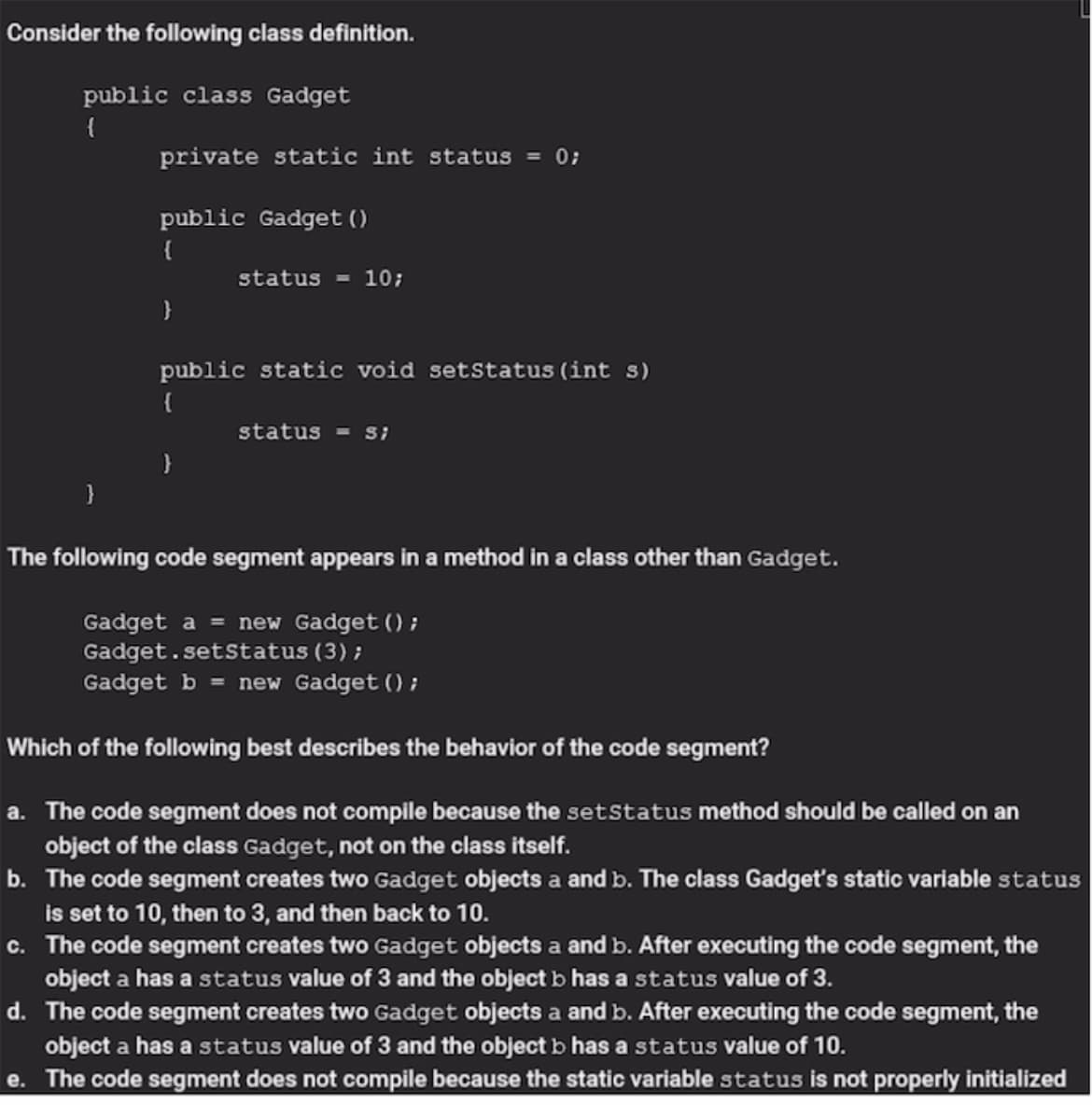onsider the following class definition. public class Gadget { private static int status = 0; public Gadget () { status = 10; public static void setstatus (int s) { status - si he following code segment appears in a method in a class other than Gadget. Gadget a = new Gadget () ; Gadget.setstatus (3) ; Gadget b = new Gadget () ; Which of the following best describes the behavior of the code segment? The code segment does not compile because the setstatus method should be called on an object of the class Gadget, not on the class itself. The code segment creates two Gadget objects a and b. The class Gadget's static variable statu. is set to 10, then to 3, and then back to 10. The code segment creates two Gadget objects a and b. After executing the code segment, the object a has a status value of 3 and the object b has a status value of 3. The code segment creates two Gadget objects a and b. After executing the code segment, the object a has a status value of 3 and the object b has a status value of 10. The code segment does not compile because the static variable status is not properly initialized
onsider the following class definition. public class Gadget { private static int status = 0; public Gadget () { status = 10; public static void setstatus (int s) { status - si he following code segment appears in a method in a class other than Gadget. Gadget a = new Gadget () ; Gadget.setstatus (3) ; Gadget b = new Gadget () ; Which of the following best describes the behavior of the code segment? The code segment does not compile because the setstatus method should be called on an object of the class Gadget, not on the class itself. The code segment creates two Gadget objects a and b. The class Gadget's static variable statu. is set to 10, then to 3, and then back to 10. The code segment creates two Gadget objects a and b. After executing the code segment, the object a has a status value of 3 and the object b has a status value of 3. The code segment creates two Gadget objects a and b. After executing the code segment, the object a has a status value of 3 and the object b has a status value of 10. The code segment does not compile because the static variable status is not properly initialized
Chapter11: Advanced Inheritance Concepts
Section: Chapter Questions
Problem 5PE
Related questions
Concept explainers
OOPs
In today's technology-driven world, computer programming skills are in high demand. The object-oriented programming (OOP) approach is very much useful while designing and maintaining software programs. Object-oriented programming (OOP) is a basic programming paradigm that almost every developer has used at some stage in their career.
Constructor
The easiest way to think of a constructor in object-oriented programming (OOP) languages is:
Question

Transcribed Image Text:Consider the following class definition.
public class Gadget
{
private static int status = 0;
public Gadget ()
{
status - 10;
public static void setstatus (int s)
{
status
The following code segment appears in a method in a class other than Gadget.
Gadget a = new Gadget () ;
Gadget.setstatus(3);
Gadget b = new Gadget () ;
Which of the following best describes the behavior of the code segment?
a. The code segment does not compile because the setstatus method should be called on an
object of the class Gadget, not on the class itself.
b. The code segment creates two Gadget objects a and b. The class Gadget's static variable status
is set to 10, then to 3, and then back to 10.
c. The code segment creates two Gadget objects a and b. After executing the code segment, the
object a has a status value of 3 and the object b has a status value of 3.
d. The code segment creates two Gadget objects a and b. After executing the code segment, the
object a has a status value of 3 and the object b has a status value of 10.
e. The code segment does not compile because the static variable status is not properly initialized
Expert Solution
This question has been solved!
Explore an expertly crafted, step-by-step solution for a thorough understanding of key concepts.
This is a popular solution!
Trending now
This is a popular solution!
Step by step
Solved in 4 steps with 1 images

Knowledge Booster
Learn more about
Need a deep-dive on the concept behind this application? Look no further. Learn more about this topic, computer-science and related others by exploring similar questions and additional content below.Recommended textbooks for you

EBK JAVA PROGRAMMING
Computer Science
ISBN:
9781337671385
Author:
FARRELL
Publisher:
CENGAGE LEARNING - CONSIGNMENT

Programming Logic & Design Comprehensive
Computer Science
ISBN:
9781337669405
Author:
FARRELL
Publisher:
Cengage

EBK JAVA PROGRAMMING
Computer Science
ISBN:
9781337671385
Author:
FARRELL
Publisher:
CENGAGE LEARNING - CONSIGNMENT

Programming Logic & Design Comprehensive
Computer Science
ISBN:
9781337669405
Author:
FARRELL
Publisher:
Cengage